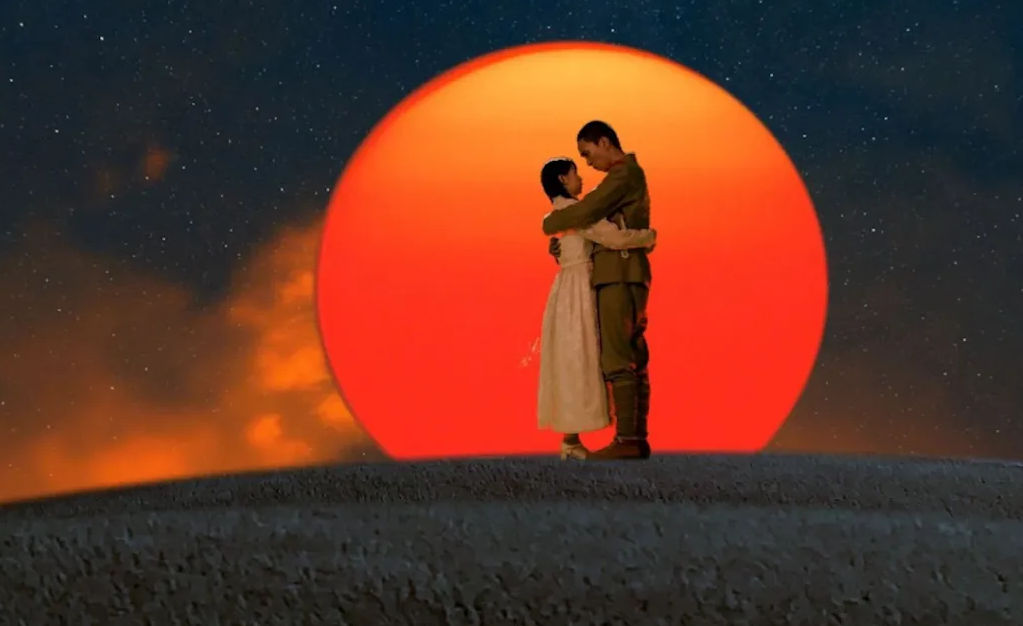Labyrinth of Cinema
Written and directed by Nobuhiko Ôbayashi
Starring Tadanobu Asano, Takuro Atsuki, Yoshihiko Hosoda and Takahito Hosoyamada
Language: Japanese
Running time: 2 hours and 59 minutes
Unrated-contains some love scenes and suggested nudity and some war scenes with some light violence
by Benjamin Leonard, Best Boy
I’ll admit my ignorance going into this one. I was pouring over the big ole list of films being offered at Fantasia International Film Fest this year and something about this one just called out to me. The brief synopsis that it was the history of Japanese wars as told through the movies had me intrigued. Seeing that it was three hours long had me a bit concerned, but a super fast IMDb check told me that Nobuhiko Ôbayashi had been making films for 60 years. Between that knowledge and a glimpse at a few stills from the film I figured it would be a fun ride. It DID NOT, however, click in my head that I actually knew that this was the final film from the famed director of House (or Hausu) that had just passed away earlier this year. Fantasia has films for so many unknown (or little known) filmmakers and I was looking at so many titles at once that my eyes just glazed over and I missed the connection. Thankfully, my instincts pushed me towards this even though my brain wasn’t working at the time.
As the synopsis said, Labyrinth of Cinema opens telling us that it is a movie to explore cinematic literature, guided by the poetry of Chūya Nakahara (1907-1937). Nakahara was known as the “Japanese Rimbaud”, but was not just an “Eastern copy of Western literature”. He was massively influential on molding Japanese poetry of the early Shōwa era. Now, all of this may sound quite heady but, rest assured, the story is loaded with light-hearted silliness and sweet sentimentality and, often, it visually resembles the work of Nathanial Hörnblowér (director of the majority of the Beastie Boys music videos). The “spaceship” that our narrator is in looks like it’s straight out of the “Body Movin’” video.
It’s clear that Ôbayashi wanted to wrap up his filmography (and life) with one big gesture that encapsulated his love of cinema, his hate of war and his hopes for the future of humanity. It’s a lot to accomplish (even within three hours) and he knew he had a very limited amount of time to work with (having been diagnosed with terminal cancer). If this were an early or mid-career effort by a filmmaker you might consider it a fool-hardy effort and overly ambitious but, if like Ôbayashi, their intentions were this pure, it’d be hard not to be moved by this film.
Following the narrative lines of Labyrinth of Cinema can be rather difficult. Some characters are in modern times, some are in the past or the future, many are characters in movies that may or may not be historical while many others jump between these stories Quantum Leap style taking the knowledge they’ve gained in the other storylines with them. At about 79 minutes in there’s an intermission and I was feeling a bit overwhelmed by it all but, after that, I kinda settled in and realized that it wasn’t the specific stories that were the goal but the common threads and characters throughout them.
Political and cinematic history are sprinkled throughout the film with a dash of literature here and a bit of philosophy stirred in there, but none of it is so deep that it drags you down from Ôbayashi’s uplifting message that the ultimate goal of humanity’s future must be peace and harmony.
While I don’t think this movie is for everyone, I think I’ve given an appropriate description for you to make your own decision here. If what I’ve said sounds like a whole lot of nonsense, you’ll likely think the same of Labyrinth of Cinema but if it sounds like a curious adventure I think you’re likely to find one here.
Maybe it’ll inspire you to make a change. As the film says for itself, “If I just watch, nothing will change.” “It’s as if movies demand I do something with my life.”
If you’re in Canada, you can check it out via Fantasia Film Fest on Monday, August 31st at 5:00PM.


